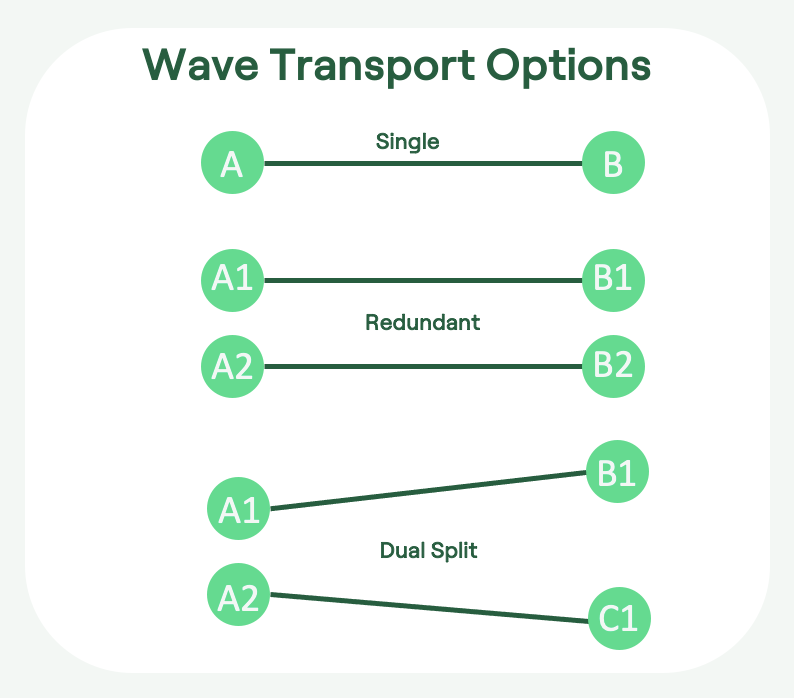

Wave
Real time storage synchronisation and data replication between datacenters
Ultra high capacity & super low latency
Wave Transport uses optical equipment to create a connection between two locations with a fixed path. The technology doesn’t use switches and is completely transparent, allowing to add VLANs as required.
Futhermore, as the the bandwidth of Wavelength Services is guaranteed and the delivered circuit is reserved specifically for the customer, Wavelengths are highly secure connections. The nature of the technique guarantees that there can never be any question of packet loss.
The excellent reliability of Wavelengths make it the perfect solution to carry out heavy duty tasks such as real time storage synchronisation and data replication tasks between datacenters.
Optionally, NL-ix delivers OTU2, OTU4 or fiber channel 8.
Single
A single transparent optical fiber path between two NL-ix endpoints with a single hand-off and a single cross connect. Since Wavelength Services Single Standard is 100% dedicated with a fixed route there is no failover.
Dual
Wavelength Services Dual provides two geographically separated fiber connections which terminate on two different hand-offs per location and therefore provides hardware redundancy.
Dual Split
Sometimes it is preferred to connect to two geographically separated POP locations. For these type of requirements NL-ix offers the Dual Split version. The main difference with Dual Split is that one main customer location is connected to two different POP locations.

Single Redundant
The Single variant is also available in a Redundant version. This version has two fiber paths built into its topology which both end on the same hand-off and can be delivered both in active/active or active/passive setup. In case of the active/passive setup, the secondary path acts as a carrier-managed failover in case the primary cable is damaged: the traffic will automatically be rerouted to the secondary path and your service will stay up.
In case of the active/active setup, both connections are active, so the user of the connection is responsible for the failover and capacity management.
Dual and Dual Split Redundant
Also the Dual and Dual Split topologies are available in Redundant version, where an additional back-op fiber route is provided on both lines. In this situation, the back-up fiber is delivered as passive, meaning the secondary path acts as a carrier-managed failover in case the primary cable is damaged: the traffic will automatically be rerouted to the secondary path and your service will stay up.
Key Features
Wide variety of traffic
Wavelengths are protocol transparent for Layer 2 and higher, and can run all types of traffic including standard Ethernet, Q-in-Q, Vlan Ethernet trunks and MPLS.Lowest latency data Transport with guaranteed bandwidth.
For applications requiring instantaneous data synchronization, Wave services support real-time data replication between datacenters, ensuring consistency and reliabilityEnd-to-end management of links between the datacenters by NL-ix.
NL-ix offers Wave capacity between nearly all datacenters where it has a POP presenceDifferent protection scenarios and SLA types are available
Use case:
Linking the most important datacenters in Europe
Wavelength services, commonly known as Wave, find utility in connecting datacenters, particularly in scenarios involving Disaster Recovery environments or real-time data replication . The primary use cases for Wave services include:
- Real-time data replication for applications requiring instantaneous data synchronisation, Wave services support real-time data replication between datacenters, ensuring consistency and reliability
- Disaster recovery providing a reliable and high-capacity connection between primary and backup datacenters, ensuring business continuity in the event of a disaster
- Large file transfer such as videos, transferring large files swiftly and securely, optimising data transfer efficiency
- Low latency and guaranteed bandwidth Wave services offer the lowest latency data transport, making them suitable for applications where real-time responsiveness is essential, such as financial transactions or video conferencing.
Moreover, organisations opting for a hub and spoke network topology leverage Wave services for streamlined access to centralized servers and enterprise resources. The inherent privacy of Wave services, allowing for centralised firewalling without the need for deploying edge security at each node of the Wide Area Network (WAN) results in architectural simplicity, reduced complexity, and cost-effectiveness in network management for such organisations.
Not sure what you need or want to know more? Our sales is always ready to help you
-
Transport technologies explained
VPLS, Optical, Ethernet, DWDM... Getting a bit confused?
Read more about the different Transport Technologies
Read more -
Datacenter overview
NL-ix offers Wave services between the neutral datacenters where it is present, and can use partners to connect other non-datacenter locations to an NL-ix covered datacenter.
See all locations where Waves are available
Read more -
Network Health Monitor
If you value low latency just as much as we do, the Network Health Monitor as an absolute must!
Find out more about the Network Health Monitor
Read more